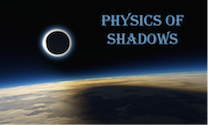Events for the 2017 Western Kentucky Physics Olympics
Judges determine the overall winner based on each team's score in the five different events.
Do-Ahead Event: Surprising Shadows
The goal for this Do-Ahead Project is to create an aesthetically pleasing image of a shadow cast by things that would not obviously create that single shadow. Designing this same thing to cast distinct shadows with alternate illumination earns more points.
 |
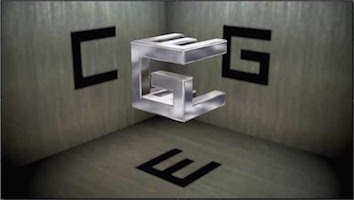 |
| Figure 1 |
Figure 2 |
- Teams create a physical object or system of objects that, when properly illuminated, will cast an aesthetically pleasing shadow. Additional points may be earned if a completely different shadow is cast when the object(s) are illuminated from another direction or location.
- The image(s) of the shadow(s) will each be judged according to:
- artistry,
- cleverness of the surprise factor, and
- documentation.
- All images and documentation must be delivered as electronic files to gelderman@wku.edu. Submissions must be received by 4pm February 22nd.
- The written documentation of your photo should clearly and concisely describe information about the physical set-up used to create the shadow image. Examples from similar photo are provided here.
- Illustrations documenting each photo must clearly indicate how the configuration of the illumination source and physical object (or system of objects) combine to cast that shadow.
An example entry meeting minimum requirements, but that would earn below average points.
- B&W photo of shadow resembling a simple house, also shows the light and objects that created it.
- Color photo of objects and location of the light source.
- Terse explanation of how the surprising shadow was formed.
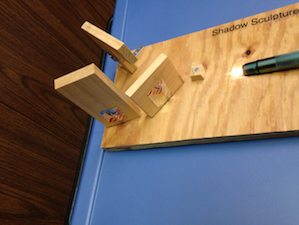 |
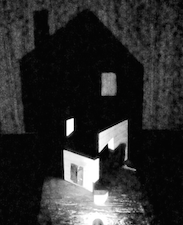 |
| Figure 3 |
Figure 4 |
| Shadow Sculptors mounted 4 plywood shapes (Figure 3) such that a shadow of a simplified house (Figure 4) is cast when a point-like source of light shines from a particular location. |
- Each image of a different shadow earns points toward the team's total score for this event. The team with the highest score wins. The first tie breaker will be the number of distinct images submitted for that team's object(s). Remaining ties broken based on cleverness sub-scores.
- All contestants will ensure that their entry works through the application of physics principles and generally follows the spirit of the competition.
Plan-Ahead Event: Camera Obscura
Each team will design and construct a pinhole projector, experiment with it to learn its capabilities, and bring it to the competition for use in this event. A pinhole camera is the world's simplest image-forming device. Invention of a device to project images was recorded in ancient China and again during early Islamic caliphates (see Figures 5 and 6). Leonardo daVinci and other artists during the Renaissance improved the design, referred to as a camera obscura {camera = Latin for room, obscura = Latin for dark}. The basis for a pinhole projector is that light entering a very small aperture will form an image with a size directly related to its distance from the pinhole.
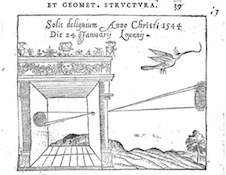 |
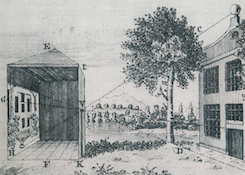 |
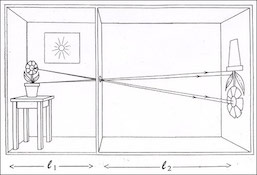 |
| Figure 5 |
Figure 6 |
Figure 7 |
- Each team shall design and construct a pinhole projector capable of providing data that will allow the members to determine properties of the event's test configurations. Excellent resources are available on the web, for instance:
- With your working pinhole projector, verify the ratio of the size of the object to the size of the image is always equal to the ratio of the distance from the screen to the object and the distance from the image to the screen. When the distance between the pinhole and screen is increased, the image gets larger, but will be less bright (see Figure 7).
- The pinhole is an important aspect of your projector. Note that a larger aperture lets in more light, but results in an image that is fuzzy (see Figure 8). A rule of thumb for the optimum diameter is roughly 1/100 of the distance from the pinhole to the screen where the image forms. For example, if that distance is 50cm then the diameter should be no wider than 5mm.
- For the competition, the organizers will provide illuminated objects to be observed by all teams. Teams will use their pinhole projector to make measurements which allow them to determine information such as the size or distance of the object.
- Rankings determined by the percent accuracy of each calculation for the information requested by the organizers, lowest first. Ties will be broken by judge's determination of image quality.
- All contestants will ensure that their entry works through the application of physics principles and follows the spirit of the competition.
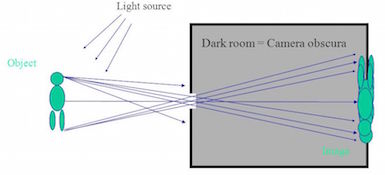 |
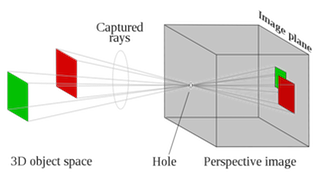 |
| Figure 8 |
Figure 9 |
Communication/Calculation Challenge: Moving Shadows
Your team will be asked to divide into two groups. The first pair receives instructions to perform an experiment involving the timing of an eclipse shadow. The second pair is briefed on how to analyze their teammates data and answer the questions posed by the organizers. The complete rules for this challenge will distributed at the start of the competition.
Impromptu Team Activity
Activity is the key word for this competition, with the goal being for each team to achieve the desired results as quickly as possible. The instructions regarding this event are not released until it begins, so everyone is on equal footing. The situation is designed to reward teamwork and common sense thinking as well as knowledge of physics. Every team will come away with smiles and good memories regardless of how well they master the particular challenge.
Order-of-Magnitude Quiz (also known as Fermi Questions)
Arrive at a reasonable approximation for the value of a complex situation with very little to no information available to directly compute the answer. In this quiz, the contestants will need to quickly make assumptions for values to use in simple calculations in order to arrive at the "correct" answer, stated as the power of ten of the number that fits the accepted value.
Teams will receive 9 questions to complete within 15 minutes. The teams can divide the work in any way they see fit, but only one answer per question per team will be accepted. Answers will be judged according to how many orders of magnitude the team's answer is from the judge's solution. The lowest score wins -- 0 points awarded for the answer accepted by the panel of judges, with 1 point scored per order of magnitude from the accepted value.
Examples of Order-of-Magnitude Quiz questions include:
- How many electrons enter the starter motor when a new, full-sized pickup starts?
- How many times would a tire of a Ford Taurus rotate when driven from NYC to LA?
- Estimate the number of gallons of gasoline used annually by all the cars in the USA.
